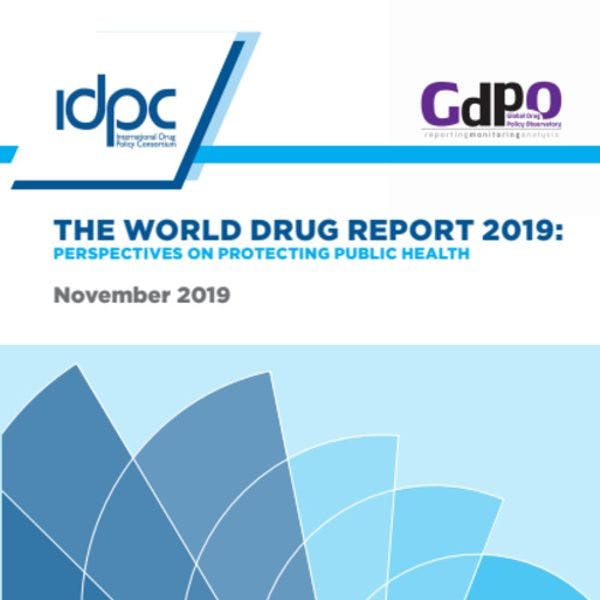The World Drug Report 2019: Perspectives on protecting public health
THE WORLD DRUG REPORT 2019: PERSPECTIVES ON PROTECTING PUBLIC HEALTH
With the Ministerial Declaration of March 2019 having ostensibly set the direction of international drug policy for the next decade or so, the launch of the 2019 World Drug Report only three months later was arguably surrounded by less expectation than the year before. Then, while missing the opportunity to provide a review of progress made in the 10 years since the Political Declaration, its contents still had the potential to feed directly into the deliberations surrounding the UN’s latest soft law instrument pertaining to drugs. Nonetheless, as is the case regardless of the UN’s own review cycle, the World Drug Report remains significant. Not only does it provide much needed information to member states about the global drug situation, generally referred to simply as the ‘world drug problem’, but its contents also do much to set the ‘mood music’ for debates within the Commission on Narcotic Drugs (CND or Commission), the UN’s central policy making body on the issue, as well as signpost key points for discussion beyond the rarefied conference rooms of the United Nations Office in Vienna. And so it was that this year’s edition of the United Nations Office on Drugs and Crime (UNODC or Office) flagship publication was launched in the Austrian capital on – as is traditional – 26 June; the United Nations International Day against Drug Abuse and Illicit Trafficking.
While retaining the separate ‘reader-friendly’ booklet format introduced in 2017, for the first time in the publication’s history this year’s Report groups drugs by their psychopharmacological effect. As such, following on from the summary and overview of latest estimates of, and trends in, supply, use and ‘health consequences’ contained within booklets 1 and 2 respectively, the three subsequent booklets look more specifically at recent trends in the markets for depressants (including opioids, sedatives, tranquilisers and hypnotics), stimulants (including cocaine, amphetamine-type stimulants and new psychoactive substances) and cannabis and hallucinogens. The substantial section on cannabis in booklet 5 also includes a full and largely unpoliticised review of the latest developments in the increasing number of jurisdictions that have adopted measures permitting non-medical use of the substance. Despite this relatively substantial re-ordering of data and related analysis, the central themes remain familiar, if more nuanced.
As one has come to expect from the UNODC, the 2019 Report – to borrow Mr. Fedotov’s words in the Preface – certainly does a great deal to ‘shed further light on the world drug problem’ (1, p. 2) across the broad spectrum of what is a multi-faceted issue area. In line with the now usual high standards, when read together, the set of booklets provide full and detailed sets of data and analysis about, among other things, fluctuations in drug crop cultivation, shifting and increasingly complex trafficking patterns (including in relation to the darknet) and the worrying and ongoing boom in the synthetic opioid market, particularly in North America. Following previous years’ practice, the Office also offers quite detailed ‘Conclusions and Policy Implications’ (1, pp. 23-29) and, acknowledging enduring uncertainty concerning many aspects of the illicit market, continues in many instances to integrate discussion of market interventions with the pursuit of the Sustainable Development Goals (SDGs). Our focus here, however, relates to several specific issues raised at various points and to varying extents within the Report. Rather than exclusively critiquing the publication itself and in its entirety, this analysis uses selectively the Report’s contents as entry points to not only highlight ongoing issues of concern but also to help initiate discussion about aspects of dynamic drug markets and associated policy responses that receive less attention. As such, using the issue of public health as a unifying theme, analysis here begins with the familiar issue of the adverse health consequences associated with the use of drugs. It then moves on to more in-depth discussion of emerging legal frameworks around regulated cannabis markets, the non-medical use of tramadol in Africa and some related discussion of data, metrics and law enforcement.
Previous reports in this series:
- IDPC response to the 2018 World Drug Report
- IDPC response to the 2017 World Drug Report
- IDPC response to the 2016 World Drug Report
- IDPC response to the 2015 World Drug Report
- IDPC response to the 2014 World Drug Report
- IDPC response to the 2013 World Drug Report
- IDPC response to the 2012 World Drug Report
- IDPC response to the 2011 World Drug Report
- IDPC response to the 2010 World Drug Report
- IDPC response to the 2009 World Drug Report
- IDPC response to the 2008 World Drug Report
- IDPC response to the 2007 World Drug Report
- IDPC response to the 2006 World Drug Report
Topics
Regions
Related Profiles
- United Nations Office on Drugs and Crime (UNODC)
